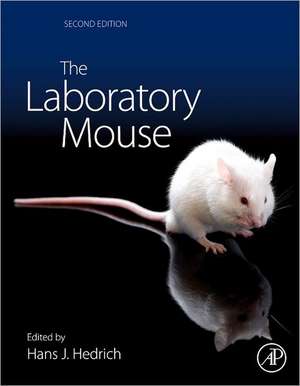The Laboratory Mouse
Editat de Hans Hedrichen Limba Engleză Hardback – 13 iun 2012
- Features four-color illustrations with complete instruction on mouse surgery, anatomy, behavior and care of the mouse in laboratory research
- Offers additional chapters on new mouse strains, phenotyping of strains, bacteria and parasites, and immunology
- Includes the newly revised EU standards on care, as well as, comparisons to standards and regulations in the US and other countries
Preț: 1357.51 lei
Preț vechi: 1797.78 lei
-24% Nou
Puncte Express: 2036
Preț estimativ în valută:
259.84€ • 282.34$ • 218.41£
259.84€ • 282.34$ • 218.41£
Carte tipărită la comandă
Livrare economică 15-29 aprilie
Preluare comenzi: 021 569.72.76
Specificații
ISBN-13: 9780123820082
ISBN-10: 0123820081
Pagini: 868
Dimensiuni: 216 x 276 x 43 mm
Greutate: 2.68 kg
Ediția:Revised
Editura: ELSEVIER SCIENCE
ISBN-10: 0123820081
Pagini: 868
Dimensiuni: 216 x 276 x 43 mm
Greutate: 2.68 kg
Ediția:Revised
Editura: ELSEVIER SCIENCE
Public țintă
The primary audience for this work is biomedical researchers, laboratory animal veterinarians, and other professionals engaged in laboratory animal sciences, as well as, academic and research libraries.Cuprins
Part 1 History and Genetics 1.1 Origin and Phylogenetic Relationship of the Laboratory Mouse 1.2 Historical Foundations 1.3 Strains, Stocks and Mutant Mice 1.4 Mouse Genomics 1.5 Generation of Mouse Mutants by Genotype-driven Mutagenesis Part 2 Anatomy and Normative Biology 2.1 Early Mouse Development 2.2 Gross Anatomy 2.3 Histology 2.4 Skin and Adnexa of the Laboratory Mouse 2.5 Development and Disease of Mouse Muscular and Skeletal Systems 2.6 The Cardiovasular System 2.7 The Respiratory Tract 2.8 The Gastrointestinal System and Metabolism 2.9 Hematology 2.10 Studying Immunology in Mice 2.11Behaviour 2.12 Biological Rhythm of the Mouse Part 3 Neoplasms and Infectious Diseases 3.1 Diversity of Spontaneous Neoplasms in commonly used Inbred Strains of Laboratory Mice 3.2 Viral Infections 3.3 Bacterial Infections of the Laboratory Mouse 3.4 Parasitic Infections of the Laboratory Mouse Part 4 Husbandry and Maintenance 4.1 Housing and Maintenance 4.2 Mouse Enrichment 4.3 Nutrition of the Laboratory Mouse 4.4 Health Management and Monitoring 4.5 Genetic Monitoring 4.6 Gnotobiology and Breeding Techniques 4.7 Cryopreservation of Pre-implantation Embryos and Gametes and associated Methods Part 5 Procedures 5.1 Handling and Restraint 5.2 Routes of Administration 5.3 Collection of Body Fluids 5.4 Anaesthesia, Analgesia and Euthanasia 5.5 Imaging the Laboratory Mouse in vivo 5.6 Necropsy Methods Part 6 Legal Regulations 6.1 Laws, Guidelines and Policies governing the Use of Mice in Research
Recenzii
"The Laboratory Mouse, Second Edition, deserves a place on the shelf of every laboratory animal medicine residency library and practitioner not only for its coverage of mouse biology and medicine, but also for its detailed descriptions of the emerging technologies and issues affecting the use of mice in research…My copy will get extensive use." --Laboratory Animal Practitioner, December 2013
"The book is enriched with excellent color figures and extensive literature…Researchers and students of the life science, medical and veterinary fields will find this book a necessary and useful tool." --Anticancer Research, Volume 33, Issue no. 5, May 201
"In general, The Laboratory Mouse is well-written and easy to read. It is a useful resource for inexperienced as well as experienced scientists who use mice as experimental animals." --Lab Animal, April 2013
"The book is enriched with excellent color figures and extensive literature…Researchers and students of the life science, medical and veterinary fields will find this book a necessary and useful tool." --Anticancer Research, Volume 33, Issue no. 5, May 201
"In general, The Laboratory Mouse is well-written and easy to read. It is a useful resource for inexperienced as well as experienced scientists who use mice as experimental animals." --Lab Animal, April 2013









